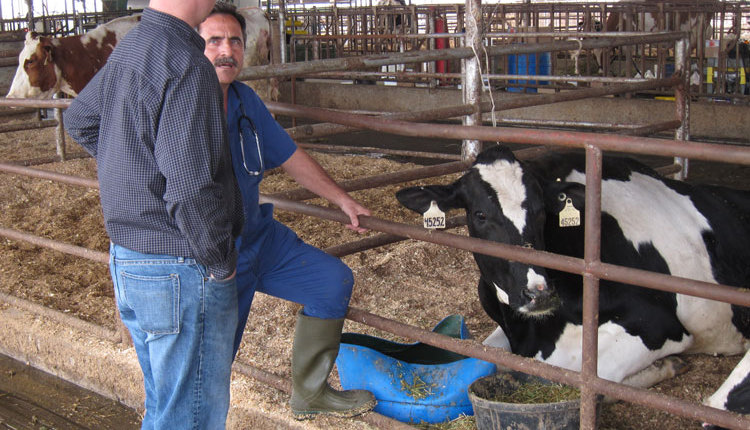The author is a partner in Maria Stein Animal Clinic, Maria Stein, Ohio.

These full breach calf positions show very little signs of labor and are the most difficult to detect. With great effort, I attempted to repel the fetus to reposition the legs. I failed. This procedure is significantly more possible in standing cows. I encouraged 569 to rise using Dan’s stock shocker. We have worked very hard to eliminate the use of stock shockers on our farms. Judicious use as a diagnostic tool for down cows has the potential to save her life, and this was one of those situations. Cow 569 made minimal effort, so Dan and I reviewed our options regarding chances of success and responsibilities as caretakers. Reality does not always give us perfect solutions.
We could pull her out of the chute, attempt a Cesarean section surgery and hope for the best. Or, we could humanely euthanize her. Our chances of success of a C-section on a cow in her condition were very, very low. It would both increase expense and add to 569’s suffering. Euthanasia would end the suffering, but can we be sure there is no hope?
I’m reminded of a similar case a few months ago where I was able to pull up one calf leg but not the other. The dairyman said that he would put the cow down with his rifle when he finished milking, and I left for church. Sunday afternoon the dairyman called to say that my partial repositioning had allowed the cow to make progress laboring, and he was able to help deliver the calf. To his surprise and mine, the cow was standing and eating. Of course, cows are amazing creatures, and we can’t perfectly predict outcomes. We have a responsibility to make the best decisions we can. Dan and I decided that euthanasia was the appropriate choice for 569.
Three options
Our next discussion was on the method of euthanasia. Ohio law allows three methods, the same three that are supported by the American Veterinary Medicine Association and American Association of Bovine Practitioners nationwide. These three methods include gunshot to the brain, rendering unconsciousness with a penetrating captive bolt possibly followed by a second step, and barbiturate injection. Each of these methods has advantages and disadvantages.
Some are very comfortable and proficient using gunshot, but I have seen it go badly even in the hands of those thoroughly trained in its use. Many farms have decided that there are too many risks involved in having a gun on the farm; that it is absolutely not the method for them to use. There are some farms that do not have U.S. citizens on the farm who can obtain a permit to have a weapon. If you choose gunshot as the euthanasia method of choice for your farm, be sure that you have made that decision considering all of its limitations. This task should not be forced upon someone, and it should be thoroughly discussed when there is not a pending case.
Barbiturate injections have the advantage of almost always going well if the animal can be restrained enough for a trained person to administer the appropriate dose intravenously. However, there are significant disadvantages to barbiturates. The very first issue is that they are controlled drugs that should never leave the control of the veterinarian registering for them with the DEA. Transporting and storing these drugs creates a target for drug abusers who may find farms and veterinarians to be easy targets for theft. Use of these drugs creates a contaminated carcass that could and has poisoned neighborhood carnivores that might gain access to the carcass if it is not properly buried. The final, and maybe first, reason to not use barbiturates is that they are expensive. An adult cow dose costs $65, so we only reserve this method for failure of other methods. We expect that to be a very rare event.
The third approved method of euthanasia, penetrating captive bolt, is the one that we have adopted in our practice. We had many discussions in our practice about this required, but dreaded, task. Those discussions included such statements as, “We are trained to give medicines to resolve conditions. If we just had a safe, humane, inexpensive injection to accomplish this, I would prefer that.” Barbiturates are neither safe nor inexpensive.
At one time, I knew of veterinarians who used disinfectants to dissolve the respiratory center of the brain leading to respiratory arrest. Euthanasia means humane death, and these methods do not qualify and are not acceptable because when studied we learn that these disinfectants create paralysis of the large muscles before respiratory arrest, then death of the brain. This sequence is the same as experienced by drowning, far from humane.
Tool of last resort
In our discussions, one comment was, “I don’t want to hold anything up to a cow’s head to create death.” As the discussions continued, we concluded that using a penetrating captive bolt gun to do exactly that was our best choice, and we purchased another $400 piece of equipment for each truck.
Penetrating captive bolt guns use a rifle charge to drive a shaft through the skull into the brain creating instant unconsciousness and possibly death. This stunning may require a second step to induce death such as injecting concentrated KCl to stop the heart, severing the spinal cord, or severing a major artery exsanguinating the animal. We have each of these possibilities supported in our trucks, but our experience has been that, properly applied, the penetrating captive bolt gun routinely induces death by itself in adult dairy cows.
I applied the penetrating captive bolt gun to 569, and she instantly was unconscious and quickly dead.
Dan asked, “Is that your favorite tool?” I said, “Not a favorite, but one I’m glad we have, lacking other good ones for this necessary task.”
As you discuss this issue with your veterinarian, it may be good to bear in mind that the person performing euthanasia may need to be someone different than the one who works very hard to heal cows. It is an admission of defeat but a responsibility we have to our cows to help them to death when they are suffering and there is no hope for their recovery.
110825_549










